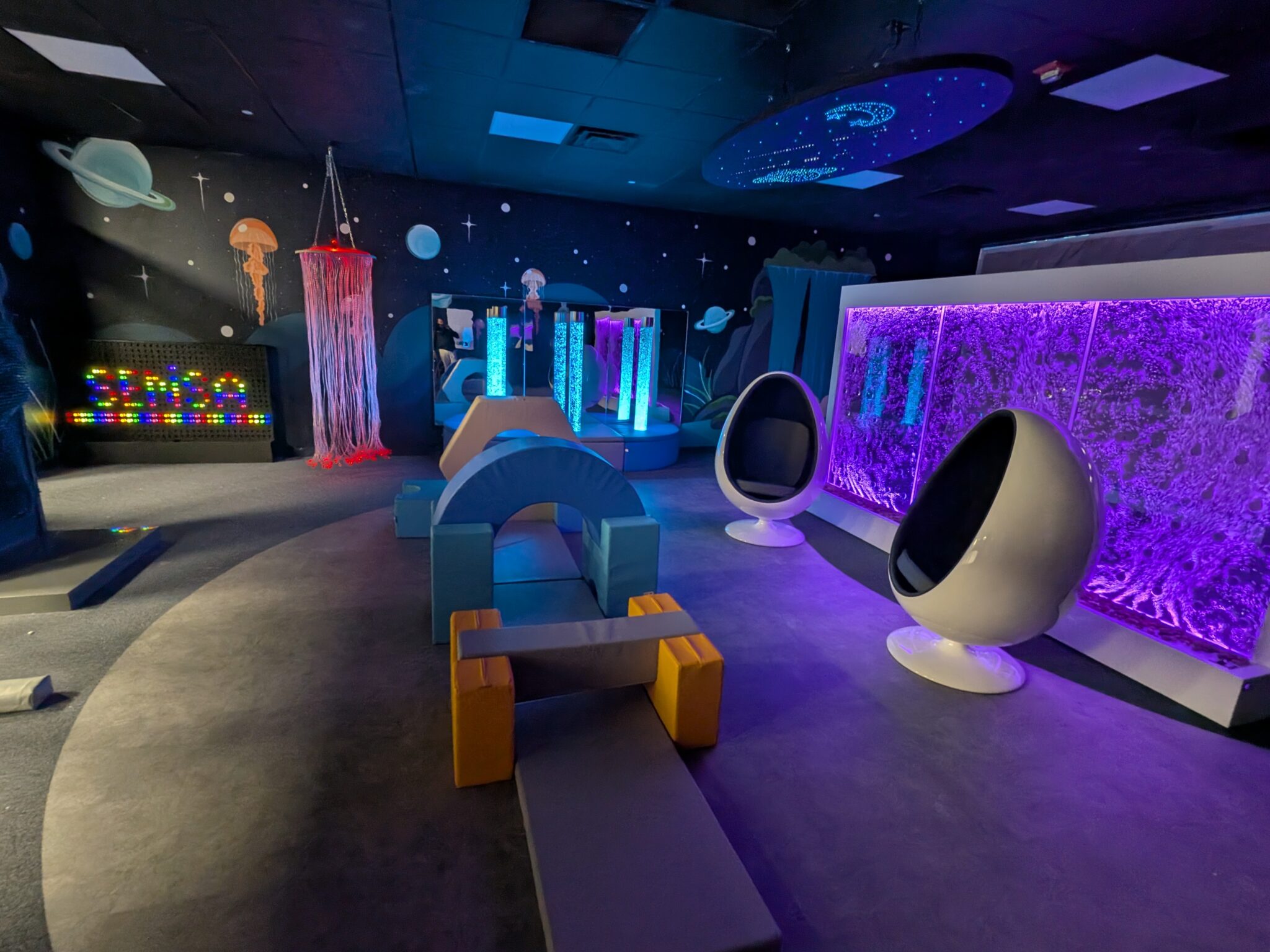The difference between a calming room and a sensory room

You may ask what makes a calming room different from a sensory room. A calming room is a quiet place. It helps you relax and feel less stressed. A sensory room is different. It has many things to see, hear, and touch. These things help you control your feelings and handle worry. Studies show sensory rooms help people pay attention. They also help people calm down and feel safe when things are too much. Knowing these differences helps you pick the right room for you.
Key Takeaways
Calming rooms are quiet places to relax and feel less stress. They have soft colors and gentle lights to make you feel calm.
Sensory rooms are exciting places with many things to see, hear, and touch. They help people use their senses and learn new things.
You should pick the room that fits your needs best. Use a calming room if you want to relax or control your feelings. Use a sensory room if you want to be active and learn skills.
Both rooms help your mind and feelings stay healthy. They help people feel safe, pay attention, and connect with others.
Leemoland has many products for calming and sensory rooms. You can make a space that fits what you need.
Calming room purpose and features

What is a calming room?
A calming room is a quiet place to relax. When you walk in, you notice it feels different. The room uses soft colors like blue and green. These colors help you feel calm and ready to rest. The bed or chair is not close to the door, but you can still see the door. This setup helps you feel safe. Sometimes, you smell lavender in the air. This smell can help you sleep well. The room has lots of natural light. This light can make you feel happier. There is no mess in the room. A clean space helps you think clearly and focus.
Tip: Calming rooms use color, light, and smell to help you feel safe and calm.
Calming room benefits
A calming room can help lower your stress and worry. Many people feel better after spending time in a calming room. You can do mindfulness activities here to relax. These activities can lower your stress hormones. In schools, students who use calming rooms have fewer problems. They spend more time working and pay better attention. Teachers see students get more involved and control themselves better.
Measurable Outcome | Impact |
|---|---|
Fewer behavior problems | Up to 50% less |
More time working | Big improvement |
More interest in learning | Teachers see a clear increase |
Better self-control | Students manage feelings better |
Fewer disruptions | Easier changes between activities |
Who needs a calming room?
You might need a calming room if you feel stressed or worried. Students often use these rooms to feel safe at school. Kids with sensory sensitivities also use calming rooms. These rooms help them handle strong feelings. A calming room can help you feel more confident and enjoy school. Many people with different needs use calming rooms to feel better and grow every day.
Sensory room explained

What is a sensory room?
A sensory room is a special place for your senses. You can see bright lights and hear different sounds. There are things to touch and smell in the room. The main goal is to give you a safe space. You can have fun with sensory activities here. Occupational therapists make sensory rooms to help you feel calm or focused. Sometimes, you might want to feel more awake. You can change the sensory equipment to fit what you like. This makes the sensory room work for many people. It helps you handle your feelings and reactions.
When you use a sensory room, you learn what helps you feel good. Therapists check what you like best. They make sure the sensory room fits your needs.
Sensory room ideas with Leemoland
Leemoland has many products for sensory rooms. You can use LED bubble tubes or fiber optic lights. Dazzling projectors make the room look cool. Noise-cancelling headphones help you block out loud sounds. Calming music can help you relax. Soft cushions and bumpy sensory balls are fun to touch. Textured wall panels give you more things to feel. Swings and balance boards help you move and rest. Essential oil diffusers make the room smell nice. Leemoland has ideas for kids and adults. Treasure baskets, sand tables, and water bead trays make the room more fun. You can use portable sensory items outside too.
Popular sensory room ideas:
Weighted blankets and squeeze machines
Interactive wall panels and sequin boards
Swings, rocking chairs, and balance boards
Who benefits from a sensory room?
A sensory room helps you focus and manage stress. You can learn new skills here. Children with autism or ADHD use sensory rooms a lot. Sensory rooms help kids practice self-control. Studies show sensory rooms help kids move better and pay attention. They also help kids talk and play with others. Adults use sensory rooms to relax and feel less worried. A sensory room is a safe place to learn coping skills. Schools, therapy centers, and homes use sensory rooms for all ages.
Study | Findings |
|---|---|
Stonefelt and Stein (1998) | Better motor skills, balance, and social skills |
Urwin and Ballinger (2005) | Fewer impulsive or harmful behaviors |
Roberts et al. (2007) | Less aggression |
Polatajko et al. (1991) | Higher self-esteem after six months |
Miller et al. (2007) | Better attention and thinking skills |
May-Benson and Koomar (2010) | Good changes in sensory processing and behavior |
Lang et al. (2012) | Better communication and school skills |
Calming sensory room vs sensory room
Key differences at a glance
You might wonder how these two rooms are different. Both rooms give you a safe place. But each room helps with different sensory needs. The table below shows how they are not the same. It lists their purpose, features, users, and use cases. This helps you pick the best sensory space for you.
Feature | Calming Sensory Room | Sensory Room |
|---|---|---|
Purpose | Calm, self-regulation, and emotional health | Sensory exploration and skill development |
Design Focus | Soothing, quiet, and safe space | Stimulating, interactive, and multi-sensory space |
Main Users | People needing to regulate emotions or stress | People needing to regulate sensory input or learn new skills |
Sensory Input | Gentle, low sensory input for calm | Varied, high or low sensory input for engagement |
Technology | Real-time adjustments for individual sensory needs | Standard sensory equipment |
Use Cases | Anxiety, sensory overload, emotional regulation | Skill-building, sensory integration, active play |
Common Features | Soft lighting, calming colors, comfortable seating | Bubble tubes, swings, textured panels, sound toys |
User Outcomes | Reduced anxiety, better self-regulation, bonding | Improved focus, motor skills, and social skills |
A calming sensory room is quiet and helps you manage your feelings. It uses soft colors and gentle lights. You see familiar things that help you relax. There is less sensory input, so it is easier to feel calm. In a sensory room, you get more sensory input. You can touch, see, and hear many things. This room helps you control your body and learn new skills.
Note: Calming sensory rooms help you feel better and control your emotions. They also help you connect with others in a safe place.
When to use each room
Pick a calming room when you need to calm down or feel safe. This room is good for schools, hospitals, and homes. It helps if you feel anxious or have too much sensory input. Kids with autism, ADHD, or sensory problems use calming rooms to feel better. Soft lights and familiar things help you feel safe and calm.
A sensory room is best when you want to try new sensory input or learn new skills. You use this room to move, balance, or practice self-control. Occupational therapists suggest sensory rooms for active needs. You might swing, bounce, or touch different textures. This helps you get better at moving, focusing, and talking to others.
Here are some examples to help you choose:
Use a calming sensory room if:
You feel overwhelmed by too much sensory input.
You need a safe place to calm down and control your feelings.
You want a quiet space for self-control.
You are in a busy or stressful place.
You want to connect with others in a calm room.
Use a sensory room if:
You want to try new sensory input and practice self-control.
You need to move or touch things to feel better.
You want to learn balance, focus, or social skills.
You like active play in a sensory space.
You need a room for therapy or learning.
Leemoland has many products for both types of rooms. You can get soft cushions, calming lights, and sensory toys for a calming room. For a sensory room, you can pick bubble tubes, swings, textured panels, and interactive equipment. These items help you control your sensory needs and make the right space for anyone.
Tip: Always plan your sensory space for your needs and goals. Good equipment and smart design help a lot.
Different ages use these rooms in special ways. Kids use calming rooms for play and learning. Teens use them to handle stress and focus. Adults use them for mental health. Older people feel less upset and confused. In sensory rooms, kids learn new skills, teens build social skills, adults stay active, and older people enjoy gentle movement.
Both rooms help you control your sensory input and meet your needs. The best room depends on what you want—calm, self-control, or learning new skills.
You have learned that calming rooms and sensory rooms are not the same. Calming rooms help you relax and control your feelings. Sensory rooms let you explore and learn new skills. Both rooms help your mind and help you be more independent. They also make school better for everyone. Picking the right calming space helps people feel safe and ready to learn. Leemoland has calming and sensory options for your needs. These choices help make good spaces for all.
Calming rooms help you feel calm and less stressed.
Sensory rooms help you focus and learn social skills.
Both rooms help you relax and feel like you belong.
FAQ
What is the main goal of a sensory room?
A sensory room lets you try new sights, sounds, and textures. This room helps you handle your feelings and actions. People with sensory processing disorders use these rooms. Sensory rooms are safe places for many sensory activities.
How do you start designing sensory rooms at home?
Begin by picking soft lights, toys with texture, and calm sounds. Think about what helps you feel good. Making a sensory room means you build a space just for you. This space should help you relax and feel safe.
Who benefits most from a sensory room?
People with autism, ADHD, or sensory processing disorders use sensory rooms. These rooms help you focus and learn new things. You can feel safe and practice skills in these rooms. Many people use sensory rooms for therapy.
Can a sensory room help with anxiety or stress?
A sensory room can help you feel calm if you are anxious or stressed. The room is quiet and helps you relax. You can touch soft things, listen to gentle sounds, or watch calm lights.
What makes sensory rooms different from regular playrooms?
Sensory rooms have special tools for sensory therapy. These rooms are not just for play. They help you manage your senses and feelings. Sensory rooms help you learn skills and feel better each day.
See Also
Designing Calming Multi Sensory Rooms: Essential Tips
Understanding Sensory Rooms: Who Benefits the Most?
Essential Elements of Effective ASD Sensory Rooms in Schools
